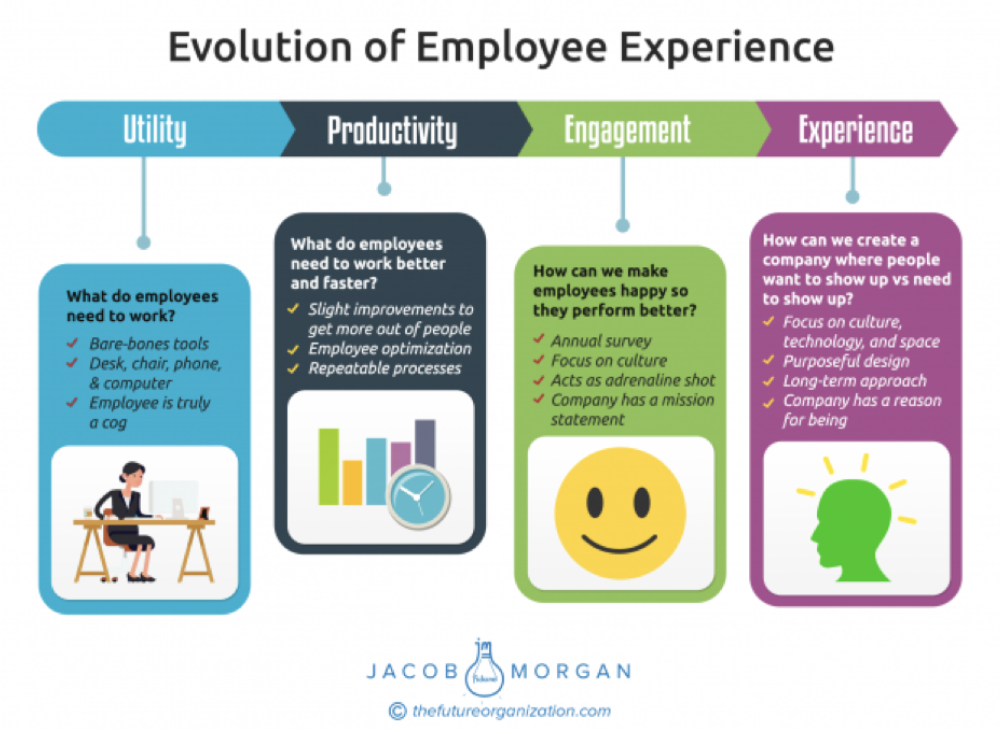Reimagining the employee experience for a human-centric world
May 26 · 9 min read

“How many?” I asked with my mouth agape.
I was helping to lead an extensive digital transformation effort for a large part of the United States federal government.
In a conversation with a senior IT manager, the subject of employee onboarding had come up, specifically how it poorly set the tone for an employee's experience when they joined the service. She explained that a new employee had to interact with 22 different departments (and, therefore, systems) to get everything they needed to start working—and that the process often took as long as 90 days.
I rattled my head in disbelief.
Of course, this was just the beginning of a long line of challenging experiences employees would face. While this may have been an extreme example, it was, unfortunately, a story I heard repeatedly.
It's no wonder, therefore, that employee experience has become a hot topic within enterprises of late. To wit, you're reading an entire magazine on the subject. And, as others have rightly pointed out, delivering a positive employee experience is about much more than just technology.
But beyond today’s multi-faceted challenges with curating and delivering an employee experience that will simultaneously increase employee satisfaction, retention, and efficiency, an even bigger problem looms on the horizon.
While organizations are taking positive first steps in this area, they’re often missing the more significant shift that they’ll need to make to sustain any of the gains they may realize.
The evolution of the employee experience
A focus on the employee experience isn’t new, per se—it’s just a somewhat new focus for the IT organization.
As Jacob Morgan, author of the book The Employee Experience Advantage, describes it, the experience organizations have delivered to their employees is evolving through four stages:

What is telling, however, is that Morgan’s interpretation of today’s employee experience is, in fact, out of sync with how many IT organizations view it.
The employee experience, as realized via the technology an organization delivers to its employees, has evolved through a parallel set of stages:
- Functional: The act of giving form and structure
- Design: Making interfaces aesthetically pleasing and consumerizing them
- Service: Making technology-enabled interactions simple, intuitive, and integrated
Most organizations are somewhere between the Design and Service stages today—and, in most cases, that is the limit of their employee experience aspirations.
But is it enough?
"[The] employee experience is not only about the technological interface that employees use as part of their work," explained Ruben Selvadoray, chief human resource officer at Bajaj Allianz Life Insurance, in an article published in People Matters. “It includes all interactions they have with the organization throughout their life cycle. At the core, businesses are made of people, not technology—and human-centric digitization to compliment the personal connect/touch is the essence.”
Even more broadly, Deloitte’s 2019 Global Human Capital Trends study shared that “…research shows that the most important factor of all is the work itself: making work meaningful and giving people a sense of belonging, trust, and relationships.”
It’s clear that simply creating more intuitive and pretty software will, in the end, not be enough to truly transform the employee experience.
But what will come next?
An immersive, human-centric, and reimagined future
As we move forward, the concept of the employee experience will continue to evolve in parallel from a technical and non-technical perspective.
In both cases, the driver of this evolution will be a shift in focus—away from the organization and its wish to improve retention, efficiency, and so forth—to the employee and their human needs and desires. "But just as customer experience design requires a more nuanced understanding of customers than simple demographics or economic value, employee experience design should be based on employees' drivers and desires," shared author Denise Lee Yohn in the Harvard Business Review.
Focusing on the employee’s “drivers and desires,” however, will demand a reimagining of much more than just the technology interface. “Employee experience…involves a complete redesign of the organization that puts employees at the center,” Morgan emphasized in an article for the Society for Human Resource Management. “In other words, instead of trying to force people to fit into outdated workplace practices, organizations must redesign their workplace practices to fit with their people.”
Today's efforts around making interfaces more intuitive and integrated are certainly a step in this direction. Still, they are only the beginning of what will be a much more involved process. Much as the customer experience will remain in a continual state of change for the foreseeable future as expectations continue to evolve, we can expect no end-state as we reimagine the employee experience. Still, there is an abundance of indicators that point to a future employee experience that is much more personalized and immersive.
In his research entitled Design and the Fourth Industrial Revolution, Tomás García Ferrari, senior lecturer at The University of Waikato, expressed that the intersection between design and technology would necessarily demand the elimination of functional silos and a move to more integrated, dynamic interactions—or, as he called them, conversations.
“…there is a requirement for conversation,” Ferrari stated. “In that context, ‘design can be seen as a form of conversation in which elements of the design situation are negotiated between the two parties to develop a desirable outcome’…the domain of design has expanded from form-giving to creating systems that support human interactions.”
The big picture, therefore, is that the conceptualization of the employee experience must evolve holistically to become immersive and nearly transparent to enable employees to embrace their humanity, interact and collaborate with others, and realize personal fulfillment—while they execute their particular role or function.
The net-net: The employee experience will become about much more than software, but at the same time, employees will expect that their software no longer forces them to conform to rigid ways of operating. Instead, they will expect it to adapt to their specific and individual needs and preferences, seamlessly crossing functional barriers without them even noticing, and enabling them to dynamically collaborate throughout the process.
As an IT leader, however, this may be a daunting prospect. After all, realizing that vision is far beyond the scope of IT.
And that’s the point.
The impact of tomorrow’s employee experience on today’s IT organization
As technology powers increasingly more of the employee experience, enterprises are thrusting their IT leaders into the forefront of the conversation.
Of course, the challenge is that most IT organizations employ technologists—not designers, let alone specialists in experiential design. So how can an IT organization prepare to lead the development and evolution of the employee experience in this future?
Many of IT's technical interpretations of the employee experience are, in fact, rooted in industrial design. Therefore, it is instructive to look to this field as they grapple with the same situation on a broader scale. "In order to succeed in the future, you'll have to change how you think about the job of industrial designer," extolled Max Burton writing for the Industrial Designers Society of America. “It’s no longer enough to look at design challenges through the narrow lens of aesthetics and functionality. Instead, all designers need to consider the entire experience of a product and service where the relationship between company and customer is extended over time and space.”
Therefore, the IT organization must build capabilities that will enable them to view the employee experience not from the perspective of how they interact with systems, but with how they see their role and fulfill their purpose within the organization's constructs.
Put another way, you need to break free from a systems-centric perspective in which you see the employee experience through the lens of a user interface. Instead, you need to think in terms of the individual employee journey as they interact with multiple systems in multiple ways in an attempt to fulfill their objectives—and create an integrated “interface” that adapts to each employee’s needs at any point.
From that perspective, you must then be willing to turn things upside down using this insight to rebuild systems to help your employees achieve the experience they desire. When Morgan stated that the point of the employee experience was to redesign the organization to put employees at the center of it, that necessarily included the technology that underpins the organization’s operational state.
Much of realizing the employee experience of the future, therefore, will come down to reimagining—and rebuilding—the technology stack for that purpose.
But IT will not be able to achieve this on its own. As Morgan points out, three things shape the employee experience: culture, the physical workspace, and technology. IT is only one piece of this critical but complicated puzzle.
IT’s leadership role in shaping the employee experience future
Depending on how you look at it, the evolution of the employee experience and the demands it will place on the enterprise will either be good or bad. If you believe that IT's role is to handle the technology bits and leave the business parts to "the business," you're probably not going to like what comes next.
But if you are among those who have long felt that IT needs to play a more prominent leadership role in the overall direction of the enterprise, this may be your moment.
The employee experience transcends nearly every functional domain within the enterprise. And, as stated previously, technology is becoming the predominant enabler and vehicle of its delivery. IT leaders must, therefore, seize this moment and assume a leadership role in reshaping the organization—and the technology stack—as you reimagine the employee experience.
The need for cross-functional partnership to achieve these ends is clear. “To create the human experience at work warrants an end-to-end focus similar to the way organizations think about their customer experience…we believe that HR organizations must partner closely with the business, IT, facilities, finance, and even marketing to make an impact in this area,” concluded Deloitte in its 2019 study.
Arguably, no function within the enterprise is better prepared to lead this effort forward. But to do so will require that you be willing to lead the entire effort—helping your organization reimagine all aspects of the employee experience rather than merely the technology aspects of it.
The only question is if IT is prepared to break free of its historical bindings, embrace a holistic view of the employee experience, and have the courage to reimagine everything to transform it.
